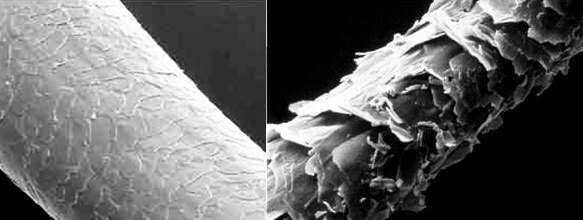
After a shower, you stand in front of a sink and mirror and start lathering. If that shower is your only pre-shave preparation and it works for you, then so be it. Carry on and have fun, but keep a styptic pencil handy for nicks and weepers. And, plan on several passes with your razor.
Full-blown shave preparation is a little more involved, and for good reason. You get a better and more enjoyable shave. And, instead of three passes and a pick-up pass, you may be able to get a smooth, close shave with two passes, or even one and a pickup.
Here’s why. Stiff stubble is harder to shave. Whiskers need to be hydrated to soften them so they slice off easily.
Whiskers are hair, just like the hair on the top of the head. Hair consists of a central core covered by layers of cuticles. Cuticles are hard shingles that protect the core, yet slip back and forth over one another to allow the hair to be pliable. When the cuticles are closed, they are nearly impervious to water and harder for a blade to cut through. The cuticles on the left are closed. Those on the right are open and damaged.

Closed cuticles are good for the hair on the top of the head. Shampooing with hot water cleans the hair, but it opens the cuticles a little. The partially open cuticles can then snag together and tangle the hairs. A conditioner closes the cuticles, untangles the hair, and adds a sheen.
Whiskers ready for shaving, on the other hand, need cuticles that are open and damaged. The whiskers can then be hydrated and softened so a blade will slip between and through the cuticles and smoothly slice off the whiskers.
There are three methods that open and damage the whisker cuticles and allow maximal hydration: Thermal, Chemical, and Mechanical. Hot water helps swell the cuticles [Thermal]. Shaving soaps have additives that swell and damage the cuticles and allow water to penetrate to the core [Chemical]. Just about every shaving soap, from the inexpensive drug store pucks to the expensive luxury creams, have these additives.
On the contrary, ordinary bath and hand soaps lack the ingredients necessary to soften the whiskers for shaving. Using your hands or a face cloth to scrub your beard with shaving soap helps the additives do their work, and the scrubbing further damages the cuticles [Mechanical]. Moreover, the soap and scrubbing remove dead skin and other gunk from your face and get it out of the way of the blade.
Consider the following full routine to prepare your whiskers, whether you shave before or after showering. A hot shower using bath soap provides only the thermal method of opening and damaging the cuticles—it is incomplete.
- Wet your face with hot water [Thermal].
- Apply shaving soap to your face either by hand or with a shaving brush. The soap does not have to be lathered [Chemical].
- Vigorously scrub your face with your hands [Mechanical]. Do not rinse off the soap.
- Wet a face cloth with hot water. Hold it on your soapy beard for 30 seconds or more [Thermal].
- Wipe off the soap with the face cloth, roughing up the whiskers a little [Mechanical].
- Repeat steps 1 through 5 if necessary to achieve thorough hydration, particularly if your beard is thick and stiff.
- Also, you may want to rub a few drops of shave oil on your face. It will add a lubricating layer that helps the razor glide easily as you shave.
Now, preparation is complete and you are ready to move on to lathering.
Is full-blown preparation necessary for everyone? No. Skip some, or even all, of the steps if you are still getting a clean, close shave with no nicks or weepers. I follow the full-blown routine because it really does help, and because it has become an integral part of my very pleasurable ritual of wet shaving.
About the Author:
Dick Edwards ([email protected]) is a retired government attorney who now has time to fully enjoy his hobbies, which include wet shaving, briar pipes, cryptic crosswords, walking, reading, and writing.
Note: This is a revised extract from an article of mine first published by the North American Society of Pipe Collectors (NASPC) in its October 2016 newsletter, The Pipe Collector, and is reprinted with permission.


Most of these points are contradicted in the literature. Check it out: https://www.badgerandblade.com/forum/wiki/Science_Of_Shaving
>Shaving soaps have additives that swell and damage the cuticles and allow water to penetrate to the core…
What are these additives called?
They are commonly called moisturizers or humectants.
Comments are closed.